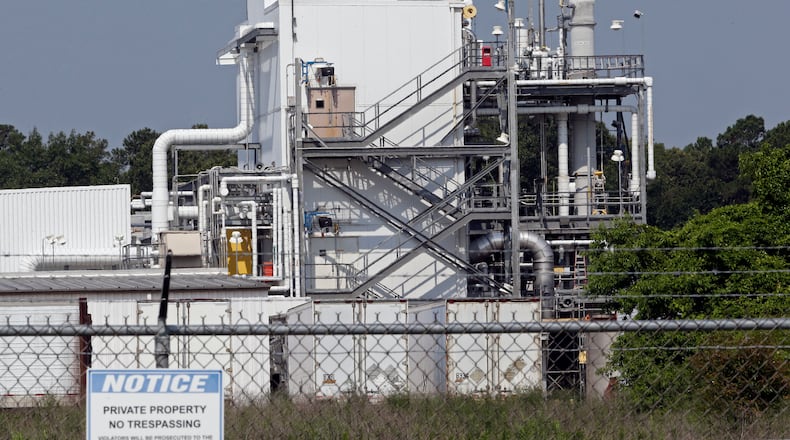Defendants named in the suit include 3M, BASF, Chemours, E.I. Dupont, Johnson Controls, Raytheon Technologies and 26 others.
The suit, filed in Greene County Common Pleas Court on Oct. 28, is part of a federal class-action case that more than 230 cities are party to, including Fairborn. Fairborn filed a similar suit in July, and both cases were transferred to the U. S. District Court for the District of South Carolina, according to federal court records.
“It appears that the action(s) on this conditional transfer order involve questions of fact that are common to the actions previously transferred to the District of South Carolina,” an Aug. 22 federal filing states.
In December 2018, 75 civil cases were sent to the South Carolina U.S. District court “for coordinated or consolidated pretrial proceedings,” federal records show.
Those cases have been assigned to Judge Richard M. Gergel. The last filing in the Fairborn case was Sept. 20, according to South Carolina records.
Per- and polyfluoroalkyl substances, or PFAS, are toxic, persistent, man-made substances that have been linked to a host of ailments, including cancer, pregnancy defects, liver and immune problems, said Tasha Stoiber, a senior scientist at Washington, D.C.-based Environmental Working Group. The chemicals have been found in firefighting foam, as well as consumer products labeled “non-stick,” or ‘stain-repellent.”
Bellbrook supplies water to residents of the city as well as parts of Sugarcreek Twp. Six out of seven Bellbrook water wells have detectable amounts of PFAS, said city councilman Forrest Greenwood.
“We’re on top of this,” Greenwood said. “If you don’t test, you don’t know.”
Bellbrook’s water is monitored, tested and treated before being pushed out to customers, said City Manager Rob Schommer, and so Bellbrook residents shouldn’t be alarmed about PFAS in their drinking water, for that reason. However, the city wouldn’t have to guard against the chemical if it was never introduced to the water system and kept in the water system to begin with.
“It isn’t a huge concern over trace amounts, but we have a responsibility to protect our community,” Schommer said. “We’re not looking for anything other than the ability to get it cleaned up and remediated. There’s ways to do that, but it’s costly.”
Bellbrook’s levels of PFAS sits around 6.9 parts per trillion, Greenwood said, referencing testing data from September this year. The EPA action level for PFAS is 70 parts per trillion.
However, the federal government is moving to tighten regulations around the “forever chemicals.” The Environmental Protection Agency (EPA) in August proposed to designate two of the most widely used PFAS chemicals as “hazardous” under the Comprehensive Environmental Response, Compensation and Liability Act, and in June, published new advisories that set acceptable levels of PFAS chemicals near zero. The EPA plans to publish national updated enforceable standards in 2023.
Depending on the extent of PFAS contamination, utilities can take contaminated wells out of service or switch water sources, if available, Stoiber siad. Utilities can also upgrade and install the necessary treatment equipment to remove PFAS, either granular activated carbon or reverse osmosis.
These costs could get passed onto rate payers, but it should be the polluter that pays to clean up the PFAS contamination, Stoiber said via email.
“Ultimately the polluters should pay,” she said. “Residents should voice their concerns with local elected officials.”
Firefighting foam containing the chemicals has previously been used at Wright-Patterson Air Force Base, though a spokesperson for the base previously told the Dayton Daily News that all legacy firefighting equipment has been replaced with foam that follows federal guidelines.
The city of Dayton filed suit against the base over contamination of its water supply in 2021, alleging that the chemicals from the foam had leached into the city’s water supply.
Fairborn’s suit seeks compensation and damages “as a result of actions and/or inactions” of the defendants involving potentially harmful chemicals in the city’s water supply.
Fairborn’s “property has been, and continues to be, contaminated with per- and polyfluoroalkyl substances (PFAS)” and other chemicals the U.S. EPA has said may have harmful health effects, the filing states.
Those other chemicals include perfluorooctanoic acid (PFOA) and perfluorooctane sulfonic acid (PFOS), the manufacturer of which spans more than 50 years, documents state.
A statement from 3M at the time of the Greene County filing said it “acted responsibly in connection with products containing PFAS — including AFFF (aqueous film-forming foam) — and will vigorously defend its record of environmental stewardship.”
Another, Tyco Fire Products, which merged with Johnson Controls in 2016, said it does not comment about ongoing litigation.


